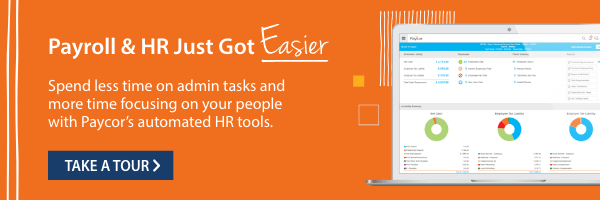Lunch Break Laws Aren’t Always a Requirement for Employers
Most employers provide their employees with a paid or unpaid lunch break, and some provide additional rest break periods. But did you know that breaks aren’t required by law? Federal law, anyway.
The Fair Labor Standards Act (FLSA), the law that governs wages and hours, does not mandate that employers provide meal or rest breaks to employees. Like many other federal laws in the human resources space, some states have stepped in to bridge the gap.
Lunch Break Laws: Here’s What You Need To Know
The federal law dictates that if an employee gets meal or rest breaks, the company does not have to pay them for that time unless:
- State law requires paid breaks
- The employee works through a break time (e.g., if they eat while working)
- It’s a shorter break that lasts 20 minutes or less
Unions and Mandatory Rest Breaks
To add to the complexity around the legality of mandatory rest and meal breaks, union collective bargaining agreements can also provide for breaks even in states that don’t require them. For example, depending on the particular collective bargaining agreement, an employee might take a 30-minute unpaid lunch break and two paid 10-minute breaks during an 8-hour shift.
Does Your State Require Lunch Breaks?
To help employers, we’ve created a chart and table explaining meal break laws at work for every state. Watch out, though: Some states’ laws apply only to employees who are minors. Check states’ laws for additional provisions and exemptions. All hours worked must be consecutive.

| State | Covered Employees | Duration |
|---|---|---|
| Alabama | 14- and 15-year-old employees who work more than 5 continuous hours Source | At least 30 minutes |
| Alaska | Under 18 scheduled to work for 5 consecutive hours without a break Source | At least 30 minutes |
| Arizona | N/A Source | N/A |
| Arkansas | Minors in the entertainment industry Source | Rest: 20 minutes They also must have at least a 10-hour break between work days |
| California | Non-exempt employees who work more than 5 hours a day *A second meal period is required if the workday is 12+ hours One paid rest break for every 4-hour period worked Source | Meal: At least 30 minutes Rest: At least 10 minutes |
| Colorado | Employees who work 5+ hours Paid rest break for every 4 hours worked Source | Meal: At least 30 minutes Rest: At least 10 minutes |
| Connecticut | Non-exempt employees who work at least 7.5 hours Source | At least 30 minutes |
| District of Columbia | N/A | N/A |
| Delaware | Employees 18+ who work at least 7.5 hours Employees under 18 scheduled to work 5 hours Source | At least 30 minutes At least 30 minutes |
| Florida | Non-exempt employees under 18 who work at least 4 hours Source | At least 30 minutes |
| Georgia | N/A | N/A |
| Hawaii | 14- and 15-year-old employees who work 5 consecutive hours Source | At least 30 minutes |
| Idaho | N/A | N/A |
| Illinois | Employees who work 7.5 hours or longer *A second meal period is required if the workday is 12+ hours Employees under 16 who work 5+ hours Source | At least 20 minutes At least 30 minutes |
| Indiana | Employees under 18 who work 6+ hours Source | 1-2 breaks totaling 30 minutes |
| Iowa | Employees under 16 who work 5+ hours Source | At least 30 minutes |
| Kansas | N/A | N/A |
| Kentucky | Non-exempt employees who work 5+ hours Paid rest break for every 4 hours worked Source | Meal: At least 30 monies Rest: At least 10 minutes |
| Louisiana | Non-exempt employees under 18 who work 5 consecutive hours Source | At least 30 minutes unpaid |
| Maine | Employees who work 6+ hours Source | At least 30 minutes |
| Maryland | Certain retail employees, per the Healthy Retail Employee Act† Non-exempt employees under 18 who work 5 consecutive hours Source | †15 minutes for a shift of 4-6 hours †30 minutes for a shift of 6+ consecutive hours †30 minutes for 8 consecutive hours, with an additional 15 minutes for every additional 4 working hours At least 30 minutes |
| Massachusetts | Non-exempt employees who work 6+ hours Source | At least 30 minutes |
| Michigan | Employees under 18 who work 5+ hours Source | At least 30 minutes |
| Minnesota | For each 4 consecutive hours worked Employees who work 6+ consecutive hours Source | At least 15 minutes (may be longer) to use the restroom and more At least 30 minutes to eat a meal |
| Mississippi | N/A | N/A |
| Missouri | Minors in the entertainment industry Source | Meal break after 5.5 hours of work plus a 15-minute rest break for every 2 hours of work |
| Montana | N/A | N/A |
| Nebraska | Employees of an assembling plant, workshop or mechanical establishment Source | At least 30 minutes per 8-hour shift |
| Nevada | Employees working 8+ hours Employees who work 3.5+ hours Source | At least 30 minutes At least a 10 consecutive minute rest break every 4 hours |
| New Hampshire | Employees who work 5+ hours Source | At least 30 minutes |
| New Jersey | Employees under 18 who work 5+ hours Source | At least 30 minutes |
| New Mexico | N/A | N/A |
| New York | Factory workers All employees who work 6+ hours Source | At least 60 minutes for the noonday meal (between 11 a.m. and 2 p.m.) and 60 minutes at the time midway between the beginning and end of the shift for all shifts of 6+ hours starting between 1:00 p.m. and 6:00 a.m. At least 30 minutes for the noonday meal and a 45-minute meal break at the time midway between the beginning and end of the shift for all shifts of more than six hours starting between 1:00 p.m. and 6:00 a.m. An additional 20-minute break between 5:00 p.m. and 7:00 p.m. for workdays that extend from before 11:00 a.m. to after 7:00 p.m. |
| North Carolina | Employees under 16 who work shifts of 5+ hours Source | At least 30 minutes |
| North Dakota | Employees who work 5+ hours Source | At least 30 minutes |
| Ohio | Employees under 18 for every 5 hours worked Source | At least 30 minutes |
| Oklahoma | Employees under 16 who work 5+ hours Employees under 16 who work 8+ hours Source | At least 30 minutes At least 30 minutes |
| Oregon | Employees for every 4 hours or greater part of 4 hours (beginning at 2 hours 1 minute) worked Employees who have worked for 6+ hours Source | At least 10 minutes for each rest break for adults At least 15 minutes for each rest break for employees under 18 At least 30 minutes |
| Pennsylvania | Seasonal farm workers for every 5 hours worked Minors under 18 for every 5 hours worked Source | At least 30 minutes |
| Rhode Island | Employees who work 6+ hours Source | 20 minutes for employees who work 6 hours 30 minutes for employees who work 8 hours |
| South Carolina | N/A | N/A |
| South Dakota | N/A | N/A |
| Tennessee | Employees who work 6+ hours Source | At least 30 minutes |
| Texas | N/A | N/A |
| Utah | Employees under 18 for every 5 hours worked Employees under 18 for every 3 hours or part thereof worked Source | At least 30 minutes At least 10 minutes for each rest break. |
| Vermont | Employers must provide a “reasonable opportunity” to eat and use the restroom. This opportunity must be paid if it is less than 30 minutes Source | N/A |
| Virginia | Employees under 16 who work 5+ hours Source | At least 30 minutes |
| Washington | Employees ages 14 and 15 for every 2 hours worked Employees ages 14 and 15 who work 4+ hours Employees ages 16+ who work 5+ hours Employees ages 16+ get a rest break for every 4 hours worked Employees working 3+ hours longer than a normal work day get an additional meal break Source | At least 10 minutes rest break At least 30 minutes At least 30 minutes At least 10 minutes At least 30 minutes |
| West Virginia | Employees who work 6+ hours Source | At least 20 minutes |
| Wisconsin | Adult employees are not entitled to meal breaks, but the Wisconsin Administrative Code recommends that employers provide such breaks Employees under 18 for every 6 hours worked | At least 30 minutes |
| Wyoming | N/A | N/A |
States Without Lunch Break Laws
Most states do not mandate meal or rest periods for adults. According to state lunch break laws, Alabama, Arizona, Arkansas, District of Columbia, Florida, Georgia, Idaho, Iowa, Kansas, Louisiana, Maine, Michigan, Mississippi, Missouri, Montana, New Jersey, New Mexico, North Carolina, Oklahoma, Pennsylvania, South Carolina, South Dakota, Texas, Utah, Virginia, Wisconsin, and Wyoming have no legal requirements for employers to provide lunch breaks or rest periods to employees 18 years and older. However, it’s important to note that some of these states do mandate lunch breaks for minor employees.
In these states without mandatory breaks, worker break laws default to federal standards, which also don’t require lunch at work for most employees. Whether or not a state requires lunch breaks, employers who voluntarily provide them must follow federal guidelines, ensuring that employees are either paid for shorter breaks or fully relieved of duties during longer, unpaid meal periods.
Penalties for Violating Lunch Break Laws
Employers who violate state lunch break laws face serious consequences that vary depending on the jurisdiction and severity of the violation. In states that require meal breaks, penalties often include fines, back pay to affected employees, and potential civil liability. Beyond financial penalties, violations of employee lunch break laws can result in regulatory scrutiny, damage to company reputation, and decreased employee morale.
California Penalties for Lunch & Rest Break Violations
California lunch break laws impose strict penalties, requiring employers to pay workers one additional hour of wages at their regular rate for each day a mandatory lunch break is denied or interrupted. Some states may also assess administrative fines that escalate with repeat violations, and employers could face lawsuits from employees seeking compensation for missed breaks.
Exceptions to Lunch Break Laws
While state lunch break laws establish general requirements for when employees must receive meal periods during their shifts, there are exemptions and special conditions that apply to certain industries and employee groups.
Minors
The most common exception involves minors, who are often granted rest and meal breaks more frequently than adults. As detailed in the state-by-state chart, many jurisdictions mandate that workers under 18 receive meal breaks after working 5 or 6 consecutive hours, whereas adult employees may not have any such protection under state law. In Maryland, retail employees have unique break laws dictated by the Healthy Retail Employee Act, which provides specific requirements that differ from other industries.
Work Requirements
Additionally, certain occupations may be exempt from mandatory lunch break requirements depending on the nature of the work. For example, some states exclude positions where public safety is at risk, where fewer than five employees are working a shift at a particular location, or where operations require employees to be available to respond to urgent conditions.
Note: Collective bargaining agreements can create exceptions to standard lunch break laws, sometimes providing more generous break provisions even in states that don’t require them.
Stay Compliant with Lunch Break Laws by Using Paycor
Navigating employee break laws can be complex, especially for businesses with multi-state operations. Fortunately, Paycor takes the guesswork out of this complexity. Our Workforce Management solutions helps you automatically:
- Track lunch breaks and rest periods
- Get alerts when employees are due for breaks
- Generate detailed reports that demonstrate your adherence to federal and state regulations.
With built-in compliance solutions that adapt to your specific location and industry requirements, Paycor helps you avoid costly penalties and ensure your employees receive the breaks they’re entitled to, so you can focus on running your business.
Interested in learning more? Take a guided tour today!
Frequently Asked Questions
For more information on meal and rest break requirements, read answers to frequently asked questions below.
Is my employer allowed to end my lunch break early due to staffing shortages or another workplace emergency?
Meal breaks are typically unpaid and not included in your work time. Your employer can’t force you to work during this break and shouldn’t interrupt your break with phone calls or work assignments. If they do, you might be able to recover to payment for the time you spent working. But, as with a lot of things, there’s an exception to the rule. If you’re the only employee on staff you might be requested to perform work duties, but this requires your agreement. If you request an uninterrupted break, your employer has to provide it.
Can an employer require an employee to take a break?
An employer cannot force an employee to take a break; however, when an employee refuses break or meal time, this should be documented.
What is the federal law on lunch breaks?
Federal law does not require meal or coffee breaks, but dictates that if an employee gets meal or rest breaks, the company does not have to pay them for that time unless:
– State law requires paid breaks
– The employee works through a break time (e.g., if they eat while working)
– The break lasts 20 minutes or less
How many breaks do you get in an 8-hour shift?
The number of breaks an employee gets for an 8-hour shift depends on the state or industry the employee works in. For example, California requires one paid 10-minute rest period for every 4 hours worked. In addition, a 30-minute meal break is required for anyone who works 5+ hours. That means in an 8-hour shift, an employee would have two rest breaks and one meal break. Arizona, on the other hand, doesn’t require employers to offer any breaks during an 8-hour shift.
Are there any exemptions or special conditions for lunch breaks in certain industries or for specific employee groups?
Yes, there are exemptions and special considerations to break laws for certain industries or employee groups. The most common employee group treated differently is minors, who are granted rest and meal breaks more frequently than adults. In Maryland, retail employees have unique break laws dictated by the Healthy Retail Employee Act.
Are lunch breaks required to be paid or unpaid in my state?
According to the U.S. Department of Labor, federal law considers short breaks (5-20 minutes) as compensable work hours, thus paid. 30-minute meal breaks are unpaid time according to federal rule, though state laws vary.
What penalties might an employer face for non-compliance with state lunch break laws?
Penalties for non-compliance with state lunch break laws vary by state but can include fines, back wages, and other legal consequences.
Paycor is not a legal, tax, benefit, accounting or investment advisor. All communication from Paycor should be confirmed by your company’s legal, tax, benefit, accounting or investment advisor before making any decisions.










